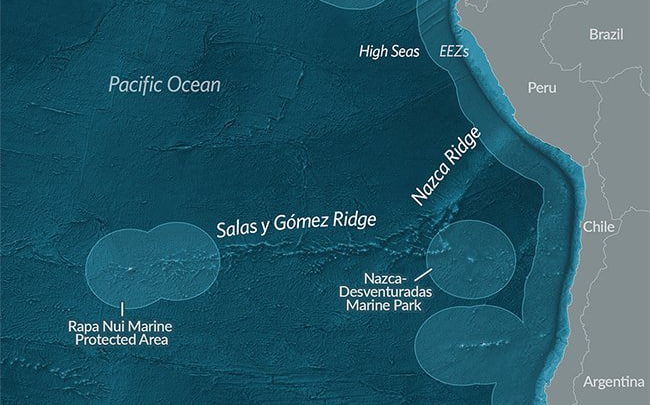Description

Copyright infringement not intended
Picture Courtesy: https://twitter.com/cristianlaborda/status/1428489599559606273
Context: Scientists discovered a large number of potentially new species while exploring the Salas y Gómez Ridge, an underwater mountain range in the Southeastern Pacific Ocean.
Key Discoveries and Implications
- Biodiversity Hotspot: A wide range of marine life was discovered during the exploration, including fish, mollusks, sea stars, glass sponges, sea urchins, crabs, squat lobsters, sea urchins, sea squid, and corals like wrinkle coral and Leptoseris. The ecological value of the Salas y Gómez Ridge is highlighted by this remarkable biodiversity.
- New Species: The discovery of potentially 50 new species suggests the presence of unique and previously unknown organisms thriving in these deep-sea environments. Identifying and documenting these species is crucial for conservation efforts and scientific understanding.
- Deep-Sea Coral Record: The sighting of Leptoseris, a deep-sea coral dependent on photosynthesis, at record depths emphasises the adaptability and resilience of marine life in extreme environments.
- Ecosystem Importance: Different ecosystems were found on each seamount that was studied, highlighting the significance of protecting entire ridges rather than to single seamounts. It is essential to maintain interconnected marine habitats by using a holistic approach.
|
Isla Salas y Gómez
●Isla Salas y Gómez, also known as Isla Sala y Gómez or Motu Motiro Hiva in the Rapa Nui language, is a small, uninhabited Chilean island located in the Pacific Ocean.
●The island comprises two rocks connected by a narrow isthmus, with a total area of approximately 15 hectares. The highest point on the eastern rock reaches 30 metres above sea level.
●The shoreline of Isla Salas y Gómez is characterised by cliffs and numerous tidepools, making it challenging to access the island except under calm sea conditions.
●The island is largely barren with minimal terrestrial vegetation, including only four species of terrestrial plants such as ferns.
●Isla Salas y Gómez serves as a rookery for seabirds, hosting approximately a dozen species of seabirds including Christmas shearwaters, masked boobies, brown noddies, and great frigatebirds.
●The island was known to the indigenous people of Easter Island (Rapa Nui), who occasionally visited to collect seabirds and eggs despite the challenging landing conditions.
|
Conservation and Protection Efforts
- Marine Protected Areas (MPAs): The scientific data collected during the expedition will be used to shape efforts to establish new MPAs, especially those in high seas locations like the Salas y Gómez Ridge. To adequately safeguard marine biodiversity, conservation initiatives must extend beyond national authorities.
- UN High Seas Treaty: The possible designation of the Salas y Gómez Ridge as a high seas marine protected area emphasises the significance of international collaboration in marine conservation. The ratification of the UN High Seas Treaty by 60 governments will allow MPAs to be established in international waters based on scientific data.
- Scientific Advocacy: The results of the mission provide vital information supporting the Salas y Gómez Ridge's ecological significance. The information gathered can be used by decision-makers to improve protection plans and evaluate conservation initiatives.
Future Research and Collaboration
- Continued Exploration: To completely understand the biodiversity and ecology of the Salas y Gómez Ridge and other such distant locations, further explorations and research are required.
- Interdisciplinary Approach: Collaboration among scientists, policymakers, and stakeholders is critical for developing comprehensive conservation programmes and ensuring sustainable management of marine resources.
- Global Awareness: The public publication of expedition findings improves awareness of the importance of marine biodiversity and the urgency of conservation efforts, resulting in increased international funding for marine protection programmes.

Conclusion
- The research mission to the Salas y Gómez Ridge revealed a previously undiscovered world of marine life and ecosystems, highlighting the importance of conserving and protecting these remote and vulnerable areas. Stakeholders can promote marine conservation initiatives and ensure the oceans' sustainability by utilising scientific data and international cooperation.
Must Read Articles:
UN High Seas Treaty
Source:
Indian Express
Wikipedia
|
PRACTICE QUESTION
Q. Salas y Gómez, recently in the news for its diverse marine life, is an island under the jurisdiction of which country?
A) United States
B) France
C) Chile
D) United Kingdom
Answer: C
|











